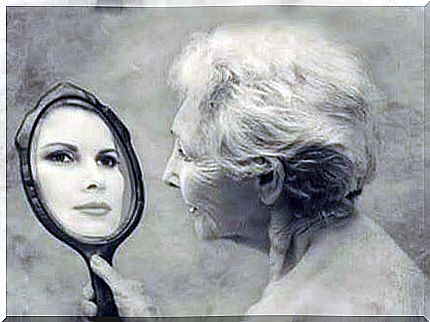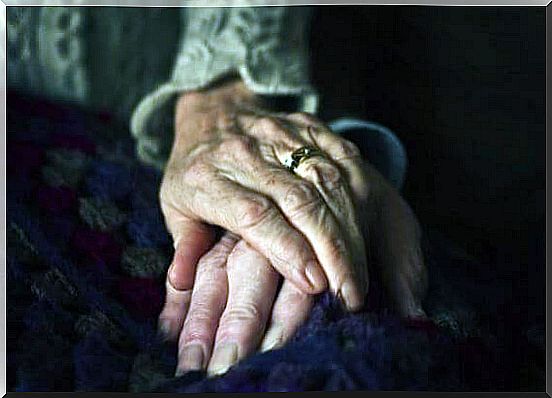The Many Faces Of Dementia

Dementia has many faces, many ways to teach us how terrible forgetfulness is. Traditionally, the most well-known type of dementia has been the one caused by Alzheimer’s disease, but this is not the only type out there. Yet it is the most common.
Contrary to popular belief, not all types of dementia are irreversible. In some cases, once the cause is identified, it can be treated and even corrected. These types of cases include: dementia due to a deficiency of vitamin B12, or dementia caused by vasculitis, hypothyroidism or hydrocephalus.
Currently, all types of dementia are included in the DSM-5 under the category of neurocognitive disorders. They are classified along with delirium, amnestic disorders and other neurocognitive disorders. These conditions do not involve cognitive loss or affectation since birth or early childhood. Therefore, there is a decrease, which becomes visible when we compare the current performance level with a previous test.

Alzheimer’s Dementia
In this case, dementia is the result of a degenerative brain disease whose causes are still unknown. Its onset is gradual, and it implies a continuous, slow and progressive decline. This type of dementia usually has an average duration of eight to ten years. Currently, this disease has no cure. Three phases can be distinguished:
The first stage (about two to four years):
The onset is usually sudden, and the main feature is a deterioration in recent memory. This is the part of the memory that refers to what is happening in the present moment. That is, people who suffer from this form of dementia experience problems with repeating daily tasks and learning.
In terms of language, it is common for the individual to lose the richness of his vocabulary. Because he finds it difficult to find the words (anomia), which he then tries to solve by using descriptions (talking about the subject) and paraphrasing. Paraphrasing consists of substituting one word for another in a similar context.
Personality changes can also occur, such as apathy (which is general laziness or lack of interest), irritability, aggression, rigidity, and so on. Stiffness in this case is understood to mean the inability to think flexibly. That is, these people become obsessed with an idea. No matter how much you try to argue with them, the idea doesn’t change.
There may also be affective changes, such as anxiety or depression. Sometimes people are aware of the onset of the disease, especially because they notice their own memory problems. In these cases, the individuals and their relatives have to adapt to a new way of life. And this is a challenge that creates stress and a lot of pain.

Second stage (about three to five years):
The intellectual decline continues, along with the appearance of the aphasic-apraxic-agnostic syndrome. This results in common forgetfulness, difficulty accomplishing simple tasks such as dressing or washing oneself, and difficulty recognizing family and objects. This syndrome means that care is needed.
Retrograde amnesia also occurs, that is, the inability to remember past events. These individuals tend to hide this by confabulating. This consists of making up events that didn’t happen to fill in the blanks in their memory. Yet people do it with no intention of lying.
Their judgment deteriorates. They become more impulsive and can no longer distinguish between right and wrong, nor do they know what the right behavior is in private or in public. Their capacity for abstract thinking also declines, making them less able to solve problems or make plans.
The rest of the symptomatology worsens and psychotic symptoms may develop. Hallucinations for example, such as saying that they spend time with their mother when she died many years ago. Or delusions, such as saying things are being stolen from them, when they are really only losing or losing them.
At this stage, they no longer know how to orient themselves in time (the hour, day, month or year they are in), nor in the space (where they live, the different rooms of the house, etc.). ). A person suffering from Alzheimer’s is currently unable to survive unsupervised. They need supervision, even if they can still perform certain basic activities independently.
Third stage (variable duration):
During this stage, the individual no longer recognizes himself in the mirror because he thinks he is younger than the person he sees in the mirror. He also no longer recognizes his next of kin. His speech gradually slows down and eventually he stops talking.
There are changes in their gait. A gait with very short steps and sliding or dragging of the feet is most characteristic. They increasingly stumble and fall, resulting in gait apraxia (the inability to walk because they have forgotten how to do this). At this stage, the patient will need help to perform basically any activity. It usually ends in bed rest.

Lewy body dementia
Lewy body dementia is one of the most difficult types to distinguish, in addition to being one of the newest discoveries. This is because it shares some symptoms with the dementia caused by Alzheimer’s and the dementia caused by Parkinson’s disease. For example, it often happens that this form of dementia is confused with other forms of dementia. It is currently considered the second most common type.
Therefore, the symptoms are mainly the following:
- Aphasic-Apraxic-Agnostic Syndrome: This is characteristic of Alzheimer’s dementia, which consists of frequent forgetfulness, difficulty performing simple tasks, and difficulty recognizing relatives or objects. In this case, it is characterized by pronounced variations when it comes to attention and alertness.
- Recurrent complex visual hallucinations: as well as auditory hallucinations and delusions. Symptoms associated with disorders related to REM sleep behavior are very common (which can be a very early manifestation), in addition to hallucinations of other types of sensory modalities, depression and delusions.
- Parkinson-like symptoms: As in Parkinson’s disease, such as tremors and stiffness of the limbs.
Spontaneous Parkinson-like symptoms are expected to arise after the onset of cognitive decline. The larger neurocognitive defects appear at least a year before the motor symptoms. They must also be distinguished from the extrapyramidal symptoms caused by neuroleptics. These are motor symptoms resulting from the medication used to treat the hallucinations and delusions. Up to 50% of individuals with Lewy body dementia are significantly sensitive to these drugs.
They often fall and suffer from other motor lapses, which are caused by a temporary loss of consciousness. These are accompanied by a temporary paralysis of the movements of the heart and breathing. This is due to a lack of blood flow to the brain, as well as unexplained ongoing periods of loss of consciousness.
Vascular dementia
Vascular dementia is caused by a number of small strokes over an extended period of time. These vascular responses are blockages or interruptions in blood flow to a particular area of the brain. This causes the neuronal death of the affected area.
For example, it is characterized by a gradual deterioration whose symptoms are difficult to predict because they depend on where in the brain the stroke occurred. It is characterized by frequent forgetfulness and orientation problems in the early stages. Also, the personality can change or the person can suffer from speech problems.

Dementia due to Parkinson’s
This type of dementia, Parkinson’s dementia, must be distinguished from Parkinson’s disease. Parkinson’s disease is characterized by tremors in the hands, arms, legs, jaw and face, stiffness in the arms, legs and torso, slowness of movement and balance, and coordination problems.
This type of dementia is characterized by the typical tremors of Parkinson’s disease, along with the cognitive slowing of the superior functions and very important emotional changes. Patients who suffer from this form of dementia are often severely depressed.
It differs from the other types in that, for example, it does not have the aphasic-apraxic-agnostic syndrome, as is the case with dementia due to Alzheimer’s. As a result, the hallucinations and delusions are not as prominent or common as in Lewy body dementia. What is striking, however, is the cognitive slowness and trembling of the body.
In this article we have described the most common forms of incurable dementia. But there are also other forms of dementia, such as the frontotemporal form, of which Picks’ dementia is the most common, Huntington’s disease, dementia associated with HIV, and dementia caused by prions.








